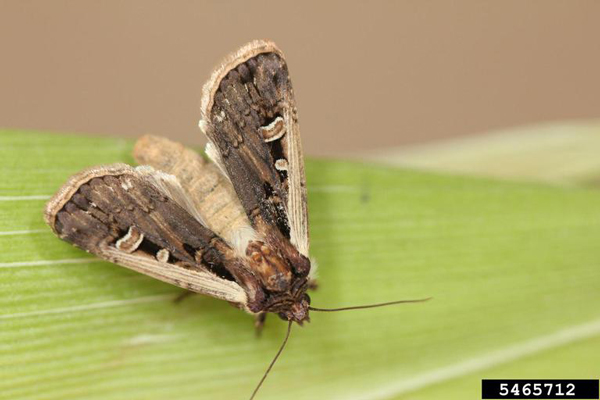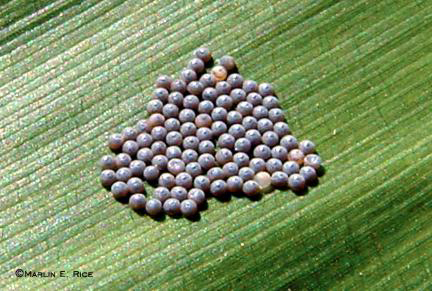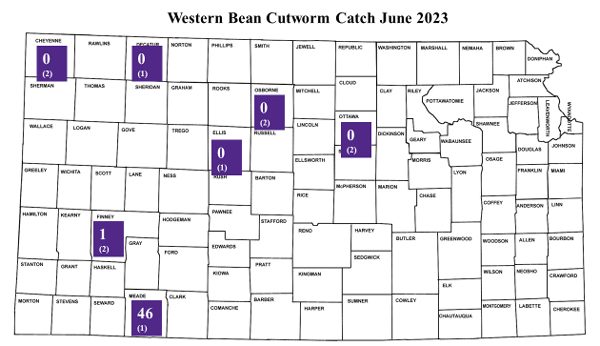Western bean cutworms are primarily a pest of corn in Kansas and activity is generally isolated to the western part of the state. This pest overwinters as pre-pupa in the soil in earthen cells about 3 to 9 inches deep. The moths begin emerging in southwestern Kansas in early June (early July for northwestern Kansas), usually around the time that corn is just starting to tassel (Figure 1). White eggs are laid in masses on the upper surface of leaves and gradually turn purple as they get closer to hatching (Figure 2). After about a week, the eggs hatch, and caterpillars enter corn ears to feed on the developing kernels. Mature caterpillars exit the corn ears and enter the soil to overwinter. There is a single generation of this pest each year.

Figure 1. Adult western bean cutworm moth. Photo by Adam Sisson, Iowa State Univ., Bugwood.org

Figure 2. Maturing western bean cutworm eggs. Photo credit: Marlin Rice.
Pheromone trap counts of western bean cutworm moths are not a metric for determining losses in corn, but can be utilized to help detect when moths start to emerge from the soil in order to properly time scouting efforts. Early detection of egg masses is important, as any chemical control if warranted, needs to happen before larvae enter corn ears. When the field is almost fully tasseled, an average of 8 % of plants with eggs or small caterpillars justify control measures. Control will be reduced if applications are delayed until all silks have emerged or if larvae have already entered the ear tips.
Currently, trap counts indicate that the western bean cutworm flight is winding down in southwest Kansas. Western Bean Cutworms began to emerge in the southwest during the second week of June and counts were low throughout the month (Figure 3). So far in July, 260 western bean cutworms have been captured in traps in Finney county with the peak weekly catch of 122 moths occurring during the first week of July. The number of captured moths is 60% lower going into the last week of the month. In Finney County, the 2023 flight is much less noticeable than in 2022 when moth counts were 64% higher. The total catch for July in Meade County is 178 moths (Figure 4) and the area is trending similarly with a peak capture of 92 moths occurring during the first week of July and trap counts are currently decreasing. The moth flight should conclude in the southwest in early August. Until then, any at-risk fields should continue to be scouted.

Figure 3. Total western bean cutworm moth captures in June. The number in parentheses indicates the total number of traps in the county. Map by Anthony Zukoff, K-State Research and Extension.

Figure 4. Total western bean cutworm moth captures in July. The number in parentheses indicates the total number of traps in the county. Map by Anthony Zukoff, K-State Research and Extension.
In northwest Kansas, western bean cutworms were not detected until the second week of July and trap numbers were very low initially. In Thomas County, the flight has picked up significantly going into the last week of July with 108 of the total moths captured over the last 7 days (Figure 4). Scouting at-risk corn for egg masses is advised in the northwest region.
Control options and additional information on western bean cutworms can be found in the 2023 Corn Insect Pest Management Guide: https://www.bookstore.ksre.ksu.edu/pubs/MF810.pdf.
Anthony Zukoff, Extension Entomology Associate
azukoff@ksu.edu
Tags: insects corn western bean cutworm